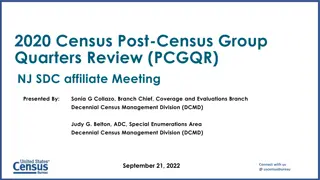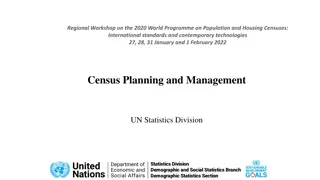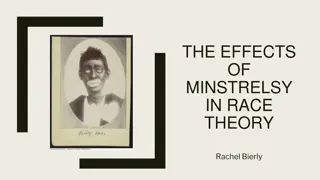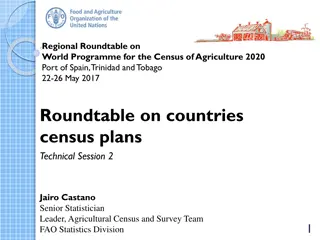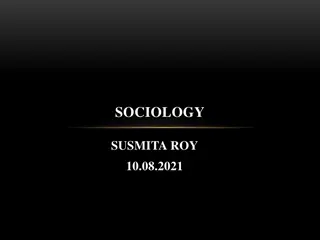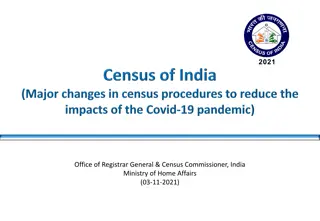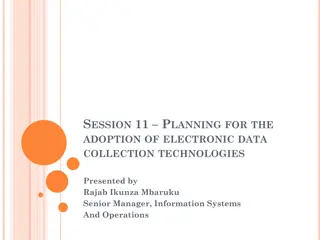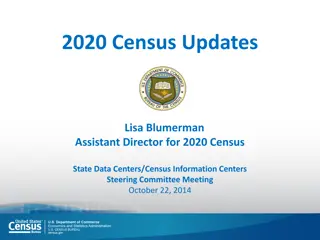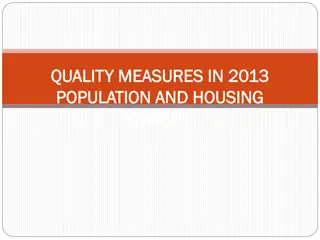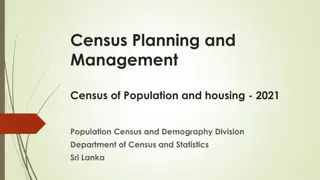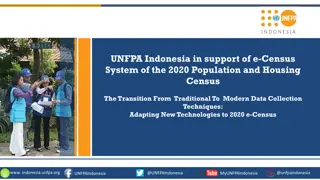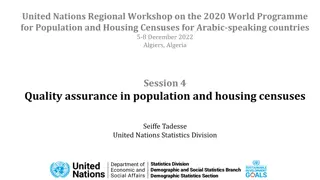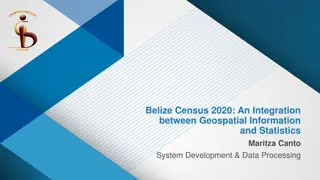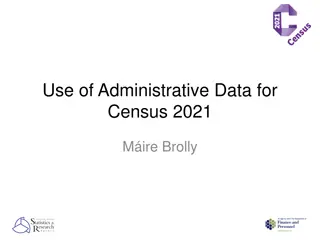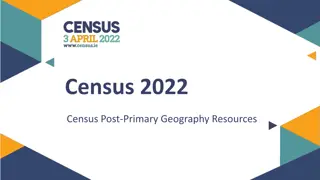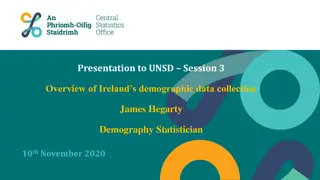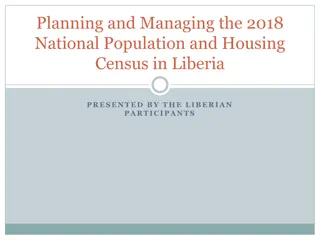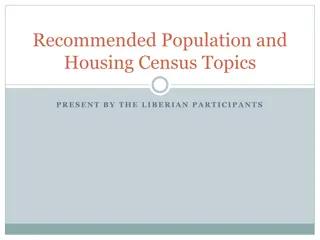Unpacking the Historical Relationship Between the US Census and Race
Dr. Karen Gaffney from Raritan Valley Community College delves into the complex historical ties between the US Census and race, exploring how categorization influenced social hierarchies and citizenship. She questions past practices, offering insights into future census considerations. The session highlights the evolution of racial classification from colonial America to modern times, shedding light on the impact of census questions on societal perceptions and structures.
Download Presentation

Please find below an Image/Link to download the presentation.
The content on the website is provided AS IS for your information and personal use only. It may not be sold, licensed, or shared on other websites without obtaining consent from the author. Download presentation by click this link. If you encounter any issues during the download, it is possible that the publisher has removed the file from their server.
E N D
Presentation Transcript
Questioning the Questions of the US Census Dr. Karen Gaffney English Department Raritan Valley Community College Branchburg, NJ Website: dividednolonger.com Email: dividednolonger@gmail.com Twitter: @dividednolonger Pronouns: she/her/hers
Questions that well consider tonight What has the relationship historically been between the US census and race? How can that history give us a framework for considering the relationship today between the US census and race? What should the census look like in the future?
Census: my sources What Is "Your" Race?: The Census and Our Flawed Efforts to Classify Americans, by Kenneth Prewitt The American Census: A Social History, by Margo J. Anderson https://usa.ipums.org/usa/ University of Minnesota https://www.census.gov/ Census Bureau NPR census analyst Hansi Lo Wang Additional references are included in my book, Dismantling the Racism Machine: A Manual and Toolbox
Census: an overview Started in 1790 Conducted every 10 years since then ( decennial ) Until 1960, people did not fill out their own forms; a census worker ( enumerator ) filled it out on your behalf Every census since 1790 has a question about a person s race
Race: an overview Invention of a racial hierarchy emerged in colonial America, when race was invented to protect the elite and divide and conquer the masses 1705: slave codes of Virginia positioned enslaved black people at bottom of hierarchy as real estate (permanent slavery that meant enslaved people were considered property) while European servants, newly called white, received specific benefits of food, money, and a weapon when they finished their temporary servitude
Race in the new nation 1790: Naturalization Act stated that only free white persons were citizens Growing dominant belief (or racial myth) in science, politics, and culture that human races were biologically different and that white people were biologically superior to black people, who were biologically closer to animals It s no surprise that the census questions reflected that belief and ultimately gave legitimacy to idea of racial categorization and to categories used Every census has a question about a person s race
Census and Constitutions Three-Fifths Clause States that enslaved people could count (using the census) three-fifths of the state s enslaved population toward representation for that state in the House of Representatives and in the Electoral College Gave states with more enslaved people more representation and power in government This greater representation didn t mean that enslaved people were being represented because they were identified as property Three-Fifths also has an enduring legacy because it symbolizes how black people have not been seen as fully human (see Dismantling the Racism Machine, page 92)
Census: 1840 New category of insane, idiotic created to compare black people who were free vs. black people who were enslaved SC Senator John C. Calhoun used census data to prove that freedom for black people causes insanity because natural condition was slavery Used to justify why Texas should be slave state Consistent with mainstream science, which perpetuated false belief white people were biologically superior (see What is Your Race? by Kenneth Prewitt, 50-51)
Census: 1870 Census Categories Color: white, black, Chinese, mulatto, Indian Directions to Census workers It must not be assumed that, where nothing is written in this column, White is to be understood. The column is always to be filled. Be particularly careful in reporting the class Mulatto. The word is here generic, and includes quadroons, octoroons, and all persons having any perceptible trace of African blood. Important scientific results depend upon the correct determination of this class in schedules 1 and 2. (see Dismantling the Racism Machine, pages 93)
Census: 1930 Census Categories Color or Race: White, Negro, Mexican, Indian, Chinese, Japanese, Filipino, Hindu, Korean Directions to Census workers The previous category Mulatto has been removed and now Negro includes A person of mixed white and Negro blood no matter how small the percentage of Negro blood Mexican is a new category: Practically all Mexican laborers are of a racial mixture difficult to classify
Census: 1930 Scholarly analysis The Census Bureau explained that the category was added because of increased immigration to the United States in the wake of Mexico s revolution of the 1920s. . . . During the economic depression of the 1930s, nearly 400,000 Mexicans and Mexican Americans living in the United States were deported to Mexico. Many Mexicans saw a link between the Mexican racial category on the census and this forced expulsion (Goodman et al. 160). (see Dismantling the Racism Machine, pages 96)
Census: 1930 and 1940 - Scholarly analysis Ian Haney L pez explains that the new census category of Mexican helped legitimize federal and state expulsion campaigns in the 1930s ( Race on the 2010 Census 44). However, that category did not remain on the census, and the 1940 census instructions explain, Mexicans are to be regarded as white unless definitely of Indian or other nonwhite race (see Dismantling the Racism Machine, pages 96)
Census: 1940 Racial category Japanese In 2018, Washington Post reported: Secret use of census info helped send Japanese Americans to internment camps in WWII (Aratani)
Post-Civil Rights Census People self-identify and fill out their own census form (since 1960) Since 2000, people can identify as more than one race (meaning check more than one box)
Post-Civil Rights: Census Bureaus website The racial categories included in the census questionnaire generally reflect a social definition of race recognized in this country and not an attempt to define race biologically, anthropologically, or genetically. Information on race is required for many Federal programs and is critical in making policy decisions, particularly for civil rights. States use these data to meet legislative redistricting principles. Race data also are used to promote equal employment opportunities and to assess racial disparities in health and environmental risks.
Post-Civil Rights: Census Bureaus website The U.S. Census Bureau must adhere to the 1997 Office of Management and Budget (OMB) standards on race and ethnicity White A person having origins in any of the original peoples of Europe, the Middle East, or North Africa. Black or African American A person having origins in any of the Black racial groups of Africa. American Indian or Alaska Native A person having origins in any of the original peoples of North and South America (including Central America) and who maintains tribal affiliation or community attachment.
Post-Civil Rights: Census Bureaus website Asian A person having origins in any of the original peoples of the Far East, Southeast Asia, or the Indian subcontinent including, for example, Cambodia, China, India, Japan, Korea, Malaysia, Pakistan, the Philippine Islands, Thailand, and Vietnam. Native Hawaiian or Other Pacific Islander A person having origins in any of the original peoples of Hawaii, Guam, Samoa, or other Pacific Islands. People who identify their origin as Hispanic, Latino, or Spanish may be of any race.
Media reports census results In 2001 Latinos Surge in Census Count Officials Surprised By 2000 Figures New Census Shows Hispanics Are Even with Blacks in U.S. In 2003 Latinos Now Top Minority In 2005 Census: Hispanics are Fastest Growing Minority In 2008 In a Generation, Minorities May Be the U.S. Majority In 2009 Projections Put Whites in Minority in U.S. by 2050
2010 Census: Questions 8 & 9 See handout for copy of 2010 Census Results: Some other race is 3rdmost popular choice, especially for people who said yes to Question 8
Questioning the Census The Census Bureau explicitly acknowledges that race is a social construct and not biological and that they want to use the data they collect to advance civil rights However, the Census Bureau uses the 5 racial categories developed in the late 1700s, which became very foundation of false and dangerous myth that race is biological and hierarchical If the racial categories and questions on the census were intended to support white supremacy in the past, what does it mean that the Census Bureau continues to use those categories today, claiming the purpose now is to advance civil rights? What should the census look like in the future?
Questions? Comments? Thanks to the NJ Council for the Humanities and the Pequannock Township Public Library Dismantling the Racism Machine: A Manual and Toolbox is available at routledge.com and Amazon and for sale here $22, cash, check, or Venmo @kjgaffney Visit my website dividednolonger.com for this Powerpoint and many resources Email me: dividednolonger@gmail.com



